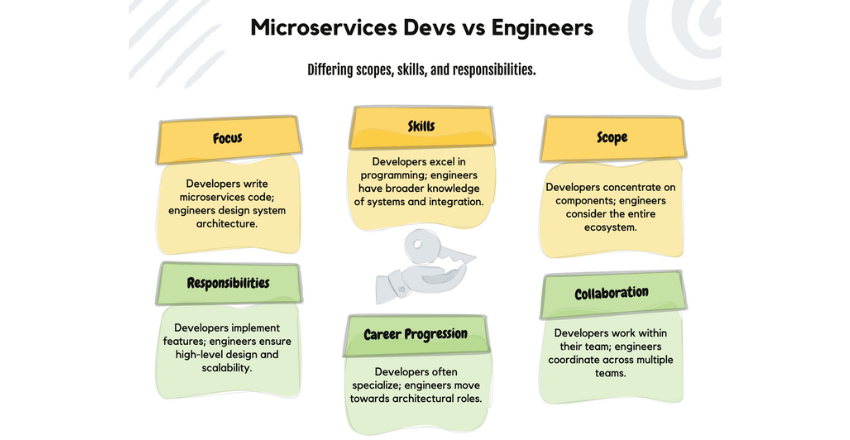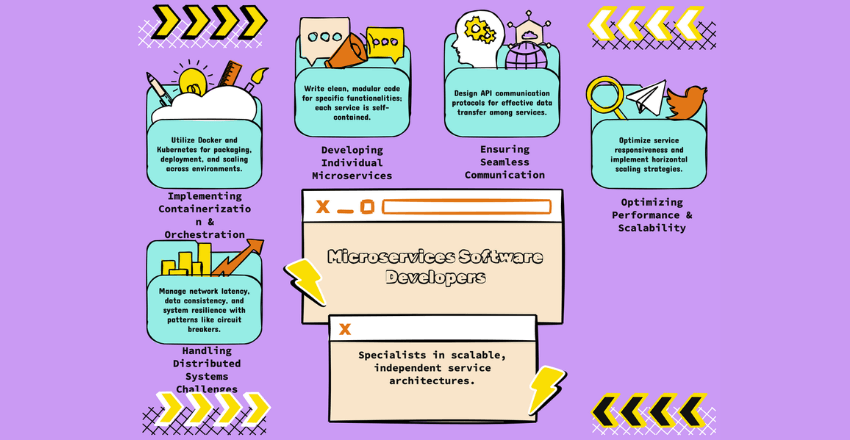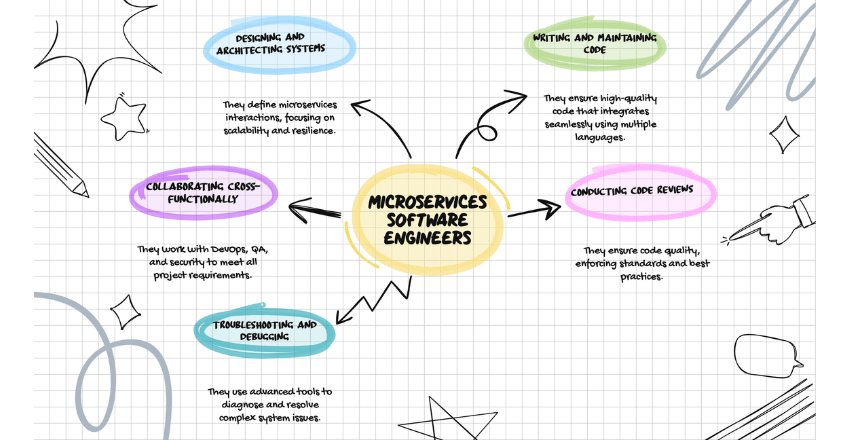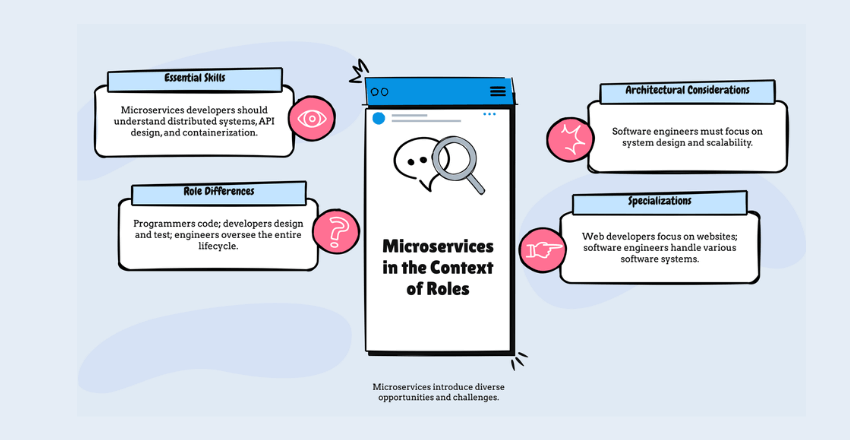
Microservices Software Developers vs Software Engineers Differences
The tech industry often treats ‘Software Developer’ and ‘Software Engineer’ as interchangeable titles, but this misconception becomes a ticking time bomb in the world of microservices. Drawing on years of experience, I’ve witnessed how this confusion ripples through the tech landscape, causing project failures, misallocated talent, and disrupted team dynamics.
Thank you for reading this post, don't forget to subscribe!To clear the fog and ensure each role is properly valued, I’ve crafted a simple guide distinguishing between Microservices Software Developers and Software Engineers. This insight aims to maximize their strengths, clarify their career paths, and ultimately lead to better project success in this critical niche.
The main differences between microservices software developers vs software engineers:
| Aspect | Developers | Engineers |
|---|---|---|
| Focus | Primarily write code for individual microservices | Design the overall system architecture |
| Scope | Work on specific components | Consider the entire microservices ecosystem |
| Skills | Excel in programming languages and tools | Require broader knowledge of distributed systems and integration patterns |
| Responsibilities | Implement features and fix bugs | Make high-level design decisions and ensure scalability |
| Collaboration | Work closely with their microservice team | Coordinate across multiple teams and services |
| Career Progression | Often specialize in particular microservices | Move towards system-wide architectural roles |
What are Microservices in Software Engineering?
Before diving into the comparison, it’s essential to understand the concept of microservices. Microservices architecture is an approach to software development where applications are built as a collection of small, independent services that communicate with each other through APIs. This design pattern has gained popularity due to its scalability, flexibility, and ease of maintenance.
According to Martin Fowler, a renowned software architect, “Microservices are an approach to developing a single application as a suite of small services, each running in its own process and communicating with lightweight mechanisms, often an HTTP resource API.” (https://martinfowler.com/articles/microservices.html)
Comparison of Roles: Microservices Software Developers vs Software Engineers
While both microservices software developers and software engineers work in the field of software development, there are notable differences in their focus areas and responsibilities.
Microservices Software Developers

Microservices software developers specialize in designing, implementing, and maintaining applications that follow the microservices architecture. This architecture involves breaking down a large application into smaller, independent services that communicate with each other through APIs.
These developers focus on creating efficient, scalable, and maintainable microservices that work cohesively within a broader system. Their primary responsibilities include:
Developing Individual Microservices:
Expertise: Microservices developers must have a deep understanding of the specific domain or functionality that a service is intended to handle. They write clean, modular, and testable code, ensuring that each service is self-contained and can operate independently of others.
Examples: A developer might create a payment processing service that handles all financial transactions in an e-commerce application, or a user authentication service that manages user logins and permissions.
Ensuring Seamless Communication Between Services:
Expertise: Developers must be adept at designing and implementing communication protocols between services, such as RESTful APIs, gRPC, or message brokers like RabbitMQ or Kafka. They ensure that data is passed correctly and efficiently between services, handling serialization, deserialization, and potential data transformation.
Examples: In a retail application, a microservices developer might ensure that the inventory service communicates effectively with the order management service to update stock levels in real-time.
Implementing Containerization and Orchestration Technologies (e.g., Docker, Kubernetes):
Expertise: Developers need to be proficient in using containerization tools like Docker to package microservices, along with orchestration tools like Kubernetes to manage, scale, and deploy these containers across different environments.
Examples: A developer might containerize a microservice for product catalog management using Docker and then deploy it on a Kubernetes cluster, ensuring it scales automatically based on demand.
Optimizing Service Performance and Scalability:
Expertise: Microservices developers focus on optimizing the performance of individual services, ensuring they are responsive and can handle high loads. They also implement strategies for horizontal scaling, where more instances of a service can be added to handle increased traffic.
Examples: A microservices developer might use caching strategies (e.g., Redis) to reduce database load for frequently accessed data or implement load balancing to distribute requests evenly across multiple instances of a service.
Handling Distributed Systems Challenges:
Expertise: Working in a microservices environment means dealing with the complexities of distributed systems. Developers must understand how to handle issues such as network latency, data consistency, fault tolerance, and service discovery. They also need to implement patterns like circuit breakers, retries, and timeouts to ensure system resilience.
Examples: A developer might implement a circuit breaker pattern to prevent a failing microservice from cascading its failure to other parts of the system, or design a service discovery mechanism that allows microservices to dynamically find and communicate with each other.
Microservices software developers play a crucial role in ensuring that each component of a microservices-based system is robust, scalable, and capable of functioning as part of a larger ecosystem. Their work requires a deep understanding of not only the services they develop but also how these services interact and contribute to the overall system’s architecture and performance.
Microservices Software Engineers

Software engineers, on the other hand, have a broader scope of responsibilities that encompass the entire software development lifecycle.
Microservices software engineers have a broad and holistic role that goes beyond just writing code. They are responsible for designing, architecting, and ensuring the successful implementation and maintenance of microservices-based systems.
Their duties span the entire software development lifecycle, requiring them to consider both the technical and operational aspects of complex distributed systems. Their duties often include:
Designing and Architecting Microservices-Based Systems:
Expertise: Microservices software engineers are responsible for the overall design and architecture of a microservices system. This involves defining how individual microservices will interact, ensuring loose coupling and high cohesion, and selecting appropriate technologies and frameworks. Engineers must consider scalability, fault tolerance, and system resilience when designing the architecture.
Example: An engineer might design a microservices architecture for an e-commerce platform, where separate services handle user authentication, product catalog management, order processing, and payment processing. They would define the communication protocols (e.g., REST, gRPC) and ensure that each service can scale independently to handle varying loads. Additionally, they might design for eventual consistency in a distributed data environment, ensuring that data integrity is maintained across services.
Writing and Maintaining Code Across Various Platforms:
Expertise: While their focus is broader than that of developers, microservices software engineers still engage in coding, particularly in the more complex or critical parts of the system. They need to be proficient in multiple programming languages and platforms, ensuring that the codebase is maintainable and integrates seamlessly with other services and platforms.
Example: A microservices engineer might write a service in Go for high-performance requirements and another in Python for easier integration with machine learning models. They ensure that each service adheres to the same API contract, making it easier for different parts of the system to communicate effectively.
Collaborating with Cross-Functional Teams:
Expertise: Microservices software engineers often work closely with various teams, including product management, DevOps, QA, and security, to ensure that the microservices architecture meets all functional and non-functional requirements. They play a key role in aligning the technical aspects of the project with business goals, facilitating communication between teams.
Example: An engineer might collaborate with the DevOps team to establish continuous integration and continuous deployment (CI/CD) pipelines that automate the deployment of microservices across different environments. They could also work with the security team to implement service-to-service authentication and encryption, ensuring that data remains secure as it moves between microservices.
Conducting Code Reviews and Ensuring Code Quality:
Expertise: Ensuring that the codebase is of high quality is a critical responsibility of microservices software engineers. They conduct thorough code reviews, not just for functionality but also for performance, security, and adherence to architectural standards. Engineers also establish best practices for the team, such as code consistency, modularity, and reusability.
Example: A microservices software engineer might review a service’s implementation to ensure it follows the best practices for error handling and logging, which are crucial in a distributed system. They might also enforce coding standards like ensuring that API endpoints are properly documented and that services have adequate test coverage, including unit tests, integration tests, and contract tests.
Troubleshooting and Debugging Complex Issues:
Expertise: When issues arise in a microservices architecture, the complexity of the system can make debugging challenging. Microservices software engineers need to have a deep understanding of the entire system, including how services interact, to effectively troubleshoot problems. They use advanced tools and techniques for monitoring, logging, and tracing to diagnose and resolve issues.
Example: An engineer might use distributed tracing tools like Jaeger or Zipkin to track requests as they pass through multiple services, identifying bottlenecks or points of failure. For example, if a payment processing service is experiencing latency, the engineer might trace the request through related services like order management and inventory, pinpointing where the delay occurs and why. They might also implement circuit breakers or fallback mechanisms to handle failures gracefully, ensuring that the entire system remains operational even if one service fails.
Microservices software engineers play a critical role in ensuring that complex, distributed systems are well-designed, robust, and scalable. Their expertise extends across various areas, from high-level architecture to low-level debugging, making them essential to the success of any microservices-based application. Their ability to balance technical depth with a broad system-wide perspective allows them to create systems that are not only functional but also resilient, maintainable, and aligned with the organization’s strategic goals.
What is the Difference Between SDE and SWE?
The terms Software Development Engineer (SDE) and Software Engineer (SWE) are often used interchangeably, but there can be subtle differences depending on the company or context:
- Focus: SDEs may have a stronger emphasis on coding and implementation, while SWEs might have a broader focus on system design and architecture.
- Industry usage: Some companies, like Amazon, use the term SDE, while others prefer SWE.
- Career progression: In some organizations, SDE might be an entry-level position, with SWE being a more senior role.
However, it’s important to note that these distinctions are not universal and can vary significantly between companies and industries.
Which is Better, a Software Engineer or a Software Developer?
The question of which role is “better” is subjective and depends on individual career goals and interests. Both roles are essential in the software industry and offer rewarding career paths.
Software engineers typically have a more comprehensive view of the software development process and may be involved in high-level decision-making. Software developers, including those specializing in microservices, often have deep expertise in specific technologies or frameworks.
A discussion on Reddit highlights the varying perspectives on this topic: Microservices software developers vs software engineers (Reddit discussion)
Microservices in the Context of Roles

The rise of microservices architecture has created new opportunities and challenges for both software developers and engineers. Microservices developers need to have a strong understanding of distributed systems, API design, and containerization technologies. Software engineers working with microservices must consider how this architecture impacts overall system design and scalability.
According to a Quora discussion, the main difference lies in the scope of work: Microservices developers vs engineers difference quora
Software Engineer vs Software Developer vs Programmer
While these terms are often used interchangeably, there are some general distinctions:
- Programmers typically focus on writing code to implement specific functionalities.
- Software developers have a broader role, including design and testing, often specializing in specific areas like microservices.
- Software engineers have the most comprehensive role, overseeing the entire software development lifecycle and making high-level design decisions.
Software Engineer vs Web Developer
Web developers specialize in creating websites and web applications, while software engineers have a broader focus on various types of software systems. Web developers may work on front-end, back-end, or full-stack development, while software engineers might be involved in developing desktop applications, mobile apps, or complex distributed systems.
Salary and Career Comparisons
Who Earns More, Software Engineer or Software Developer?
Generally, software engineers tend to earn slightly higher salaries than software developers due to their broader skill set and responsibilities. However, this can vary based on factors such as location, company, and individual experience.
According to Glassdoor, the average base salary for a software engineer in the United States is $92,046 per year, while a software developer’s average base salary is $76,526 per year. (https://www.glassdoor.com/Salaries/software-engineer-salary-SRCH_KO0,17.htm)
Microservices Software Developers vs Software Engineers Salary
Specialized skills in microservices can potentially lead to higher salaries. According to PayScale, software engineers with microservices skills earn an average of $110,000 per year. (https://www.payscale.com/research/US/Skill=Microservices/Salary)
Can a Software Developer Become a Software Engineer?
It’s common for software developers to transition into software engineering roles as they gain experience and broaden their skills. This transition often involves:
- Expanding knowledge of system design and architecture
- Developing project management and leadership skills
- Gaining experience with a wider range of technologies and platforms
- Pursuing additional education or certifications
Wrapping up
While microservices software developers and software engineers share many similarities, their roles differ in scope and focus. Microservices developers specialize in building and maintaining distributed systems using a specific architectural approach, while software engineers have a broader purview over the entire software development lifecycle.
Both roles are crucial in modern software development, and the choice between them depends on individual interests, career goals, and the specific needs of employers. As the software industry continues to evolve, professionals in both roles must stay updated with the latest technologies and best practices to remain competitive in the job market.




